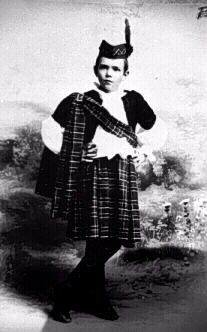 writer on etiquette expressed the prevailing view:
writer on etiquette expressed the prevailing view:
Proper dress played an important role in Victorian society. It was
an era strongly conscious, at least on the surface, of the niceties of good
form and the many gradations of social position. A contemporary
 writer on etiquette expressed the prevailing view:
writer on etiquette expressed the prevailing view:
What style is to our thoughts, dressis to our persons. It may supply the place of more solid qualities [sic], and without it the most solid are of little avail. Numbers have owed their ele- vation to their attention to the toilet. Place, fortune, marriage have all been lost by neglecting it . . . The plainest dress is always the most genteel, and a lady that dresses plainly will never be dressed unfashionably.
To modern eyes even the simplest of the costumes shown in the
catalogs of the day are far from plain. The lavish trimmings and
elaborate
draperies reflect an era in which women and children were considered
as passive and
ornamental. They are a perfect complement to the overstuffed parlors, the
plethora of ornament, and rococo richness that characterized nineteenth-
century taste.
The late 1880s was an interesting period in the evolution of boys'
clothing. Much continued on from
earlier periods. Boys still wore
dresses until they were about 4 or 5 years old. At that point many
fashion styles were available to the discerning tastes of fashion
conscious mother.
If the mother did not think her curly haired son was ready for
trousers, she could purchase suits with
kilt skirts rather than
pants. These were available in many styles, Scottish,
sailor
and after the mid1880s more elaborate jackets and blouses.
These kilt suits were generally available in sizes up to 8 years
which meant that boys as old a 9 or 10 might wear them.
Another option mothers had were tunic suits ot
Buster Brown suits.
The little tunic jacket made it look almost like a smock and in some cases covered th boys'
short, above the knee bloomer pants. The Buster Brown suits has broad white collars
and floppy bows. The tunic hackets had high collars, but generally not stiff collars
and bows. The suits were almost always worn with long stockings and
bare legs were not common.
Other mothers might decide that the time had come to cut their
little boy's
curls and purchase pants. The pants would be knee
length and worn with long over the knee stockings, help up by a
suspender waist. These short pants suits came in many of the same
styles as the kilt suits.
A new style appeared in the late 1880s after the publication of
Francis Hobson Bennet's
Little Lord Fauntleroy. Soon boys up to 10
and 11, in some cases even older, were wearing long sausage curls,
and fancy
velvet suits with delicate lace collars. Mothers loved
these outfits. The boys, especially the older ones while they were
glad to be out of kilts, hated them.
When going out side the boys in Fauntleroy and other fancy
suits, including sailor suits and Buster Brown suits, would wear
broad s-brimmed
sailor hats with long steamers and held on by an
elastic chin strap. These hats would not be worn just to church or
parties, but rather even for informal outings to the park or even the
beach. Some boys had special hats for dress up, usually ones with
especially large brims.
We are, of course, talking about children from well to do, or at
least confortably well off families. The more elaborate fahions
discussed here have nothing to do with the
common folk that laboured in factories. Fashion was a private
performance of the well-to-do until well into the 20th Century.
The children discussed here are the sons of the bourgeoisie, the
new middle class that was
neither noble nor poor but who were to dominate the European
countries and who became the trend-setters of that era. Their
wealth came, for the most part, from the new industries they financed
and the factories they ran and owned,
or from high education jobs that let them take part in the new industrial
boom. In that they were different from the nobility, whose wealth was
inherited, at leasdt in the 19th Century. So the bourgeoisie on one hand imitated the nobility by
showing off, and stressed their being different in that they had - more or less - earned
their wealth. In this context, fashion played a role in the establishment of the identity of
this new class which, by way of being new, had no tradition and no fixed identity. The lack
of identity is probably why the bougeoisie envied (thus, imitated) the nobility while at the
same time looking down their noses at them. The need to show their
new status filtered down to how they dressed their children. For some
the elaborate fashions such as the lace trimmed Fauntkleroy suits were
an attmpt to flaunt their weaklth and an attemp to emulate the pomp and extravegance of the nobility.
Related Links
Antique clothing
Navigate the Boys' Historical Clothing Web Site:
[
Introduction]
[
Chronology]
[
Clothing styles]
[
Biographies]
[
Bibliographies]
[
Contributions]
[
Boys' Clothing Home]